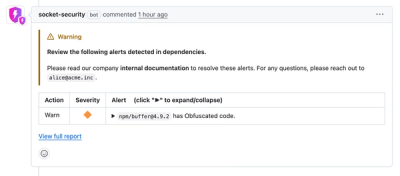
Security News
Crates.io Users Targeted by Phishing Emails
The Rust Security Response WG is warning of phishing emails from rustfoundation.dev targeting crates.io users.
SignAvatar Library Installation Guide
Python 3.7+: Make sure Python 3.7 or above is installed. Verify installation: Open a terminal and run python --version. pip: Python's package installer, used for installing dependencies. Verify installation: Run pip --version. Network Connection: A stable internet connection is required to install dependencies and retrieve online gesture resources if using URL-based videos. 2. Installation Steps Step 1: Download the SignAvatar Library Obtain the SignAvatar library code package. Clone from a repository (if hosted on GitHub or similar platform) using: bash Copy code git clone https://github.com/username/signavatar.git Or, download the library files as a .zip and extract them to your desired directory. Step 2: Install Required Dependencies Navigate to the directory containing the library files and install dependencies listed in requirements.txt.
bash Copy code cd signavatar pip install -r requirements.txt Note: The requirements file should include necessary packages such as requests for HTTP requests, json for JSON handling, and any additional dependencies used by the library.
ASLLVD/ WLASL Dataset:
Download the ASLLVD dataset (ASLLVD_videos.csv) or WLASL dataset (WLASL_videos.json). Place the downloaded dataset in the signavatar directory. File Structure Example:
Copy code signavatar/ ├── ASLLVD_videos.csv ├── WLASL_videos.json ├── signavatar.py ├── requirements.txt 4. Testing the Library Installation Once installed, test the library to verify that it is functioning as expected.
Open a Python environment (terminal or IDE).
Run the following code to initialize SignAvatar and display gesture URLs.
python Copy code from signavatar import SignAvatar
avatar = SignAvatar(language="ASL", style={"color": "blue", "brightness": 0.8}, expression="happy")
print("Loaded gestures:", len(avatar.gestures)) # Expected output: number of gestures loaded
print("Video URL for 'hello':", avatar.get_video_url("hello")) If successful, you should see output showing the loaded gestures and a video URL for the specified sign.
Test Animation Rendering: Run the following code to test the sign() method for rendering animations:
python Copy code animation_sequence = avatar.sign("Hello how are you?") print("Generated Animation Sequence:") for animation in animation_sequence: print(animation) This should return an animation sequence based on the phrase.
Copy the signavatar directory to your project’s directory.
Import and use SignAvatar methods in your project’s Python files:
python Copy code from signavatar import SignAvatar
avatar = SignAvatar() avatar.sign("Sample text to animate.") 6. Troubleshooting Module Not Found: Ensure the signavatar.py file is in the project’s root directory or PYTHONPATH. Missing Dependencies: Re-run pip install -r requirements.txt to install dependencies. Error Loading Gesture File: Confirm that the dataset file (e.g., ASLLVD_videos.csv) is present and named correctly.
FAQs
Did you know?

Socket for GitHub automatically highlights issues in each pull request and monitors the health of all your open source dependencies. Discover the contents of your packages and block harmful activity before you install or update your dependencies.

Security News
The Rust Security Response WG is warning of phishing emails from rustfoundation.dev targeting crates.io users.

Product
Socket now lets you customize pull request alert headers, helping security teams share clear guidance right in PRs to speed reviews and reduce back-and-forth.

Product
Socket's Rust support is moving to Beta: all users can scan Cargo projects and generate SBOMs, including Cargo.toml-only crates, with Rust-aware supply chain checks.